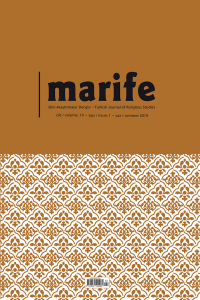
Marife Dini Araştırmalar Dergisi
Yazarlar: Ferruh KAHRAMAN
Konular:Din Bilimi
DOI:10.33420/marife.781830
Anahtar Kelimeler:Tafsīr,Arabic,Alphabet,Letters,Musned
Özet: Scholars have different opinions on the invention of writing. Islamic scholars have two main views on the invention of writing, namely revelatory and humanistic. According to the opinion that the writing is revelatory, it was first taught to prophet Idris by Allah. This type of writing probably is the phonetic/alphabetic writing that we use today. The views of other Islamic scholars who maintain the humanistic opinion and modern scientists are in accordance. These groups say that the writing did not start with revelation; On the contrary, they argue that as a human activity, it has been invented and developed by the needs in the historical process. According to modern sciences people first used object graphic writing, which they created by notching and grooving some objects. Then these shapes were transformed into drawing the image of the being and turned into pictographic writing. The best example of pictographic writing is the hieroglyphs of Ancient Egypt. Later, people were not satisfied with this and switched to idiographic writing (traditional Chinese writing), an example of which we see in Chinese. People used logographic / syllable writing after idiographic writing. In this script, each picture corresponds to a syllable. After the syllable writing, people used phonographic writing in which the symbol corresponds to a sound. Each sound has a special symbol in phonographic writing. These writings, which consist of certain signs representing sounds, are also called phonetic alphabets. The Arabic, Aramaic, Hebrew, Syrian, Latin, Greek, Indian, Georgian, and Armenian alphabets used today consist of such a system of symbols. In today’s world, alphabet writing is the most preferred type of writing. In addition to this lettered writing, some pictures, figures, and photographs are also preferred as emblem, logo, and symbol. However, the emblem, logo, and symbol are used not as an alternative to writing, but as a supporter. What matters is writing especially alphabetic writing. It is still controversial who invented alphabetic writing. Even the invention of writing, in general, continues to be debated. For, according to modern sciences, the invention of writing and the invention of alphabet writing are different things. According to the general acceptance of modern sciences, the Sumerians and Ancient Egyptians invented writing for the first time, and the Phoenicians, who were in the middle of both geographies, invented the alphabet. The first alphabet is a 22-letter writing system invented by the Phoenician Arabs in the Eastern Mediterranean much later than the invention of writing. This alphabet forms the basis of all alphabets used in the world. This is the general acceptance of modern science. In Islamic sciences, there is the information that writing was invented by Arabs in Yemen and used throughout history. This writing, which consists of 28 letters, is called Musnad. Ibn Khaldûn defends this view and takes the alphabet writing back to the people of Hûd in Yemen. Even after İsmâil (pbuh) settled in Mecca, he learned this article from the locals of Jürhüm. According to Ibn Khaldûn, who discussed the origin and development of writing in his Muqaddimah, writing is culture, civilization, art, science, and technology. According to him, civilization, art, science, and technology are also characteristics of city life. For this reason, writing, as some claim, is not an art to be invented by the Arabs of the North and West, the majority of which are Bedouin. There are also signs in the Quran that writing has been used in Yemen for a long time. For, Suleiman (pbuh) wrote a letter to the queen of Yemen Belkis and she read this letter. We think that these views of Ibn Khaldûn, who has an important place in the field of history and sociology, regarding the invention of writing, should be taken into consideration, and that the ancient Yemeni people should be mentioned along with the names of Sumerian, Egyptian, and Phoenician that came to the fore in writing.